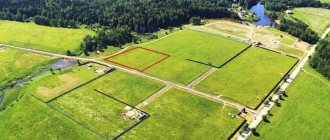The allocation of a land share from agricultural land has certain nuances, ignoring which can lead to undesirable consequences and termination of the property transaction. The specifics relate to the need to comply with certain conditions and provide a package of documents, and following the instructions will help you avoid common mistakes.
The concept of allocation of land share.
A land share is a certain part in the right of common ownership of an allotment. Allocation is usually understood as a procedure during which the boundaries of a site may change and a change of owner occurs. Shared ownership may arise during privatization, and issues of ownership and disposal of such property are regulated by the norms of the law on agricultural land.
According to the current rules, the size of the share can be determined in the following ways:
- simple proper fraction (1/50);
- hectares;
- points (6,820 b/ha).
Sometimes, when determining agricultural areas, several units of measurement can be used, but to bring them to a common denominator they are reduced to one indicator. This is often necessary to count the number of votes at a general meeting of all participants in shared ownership. Ownership rights are subject to mandatory state registration with recording of changes in the Unified Register.
The norms and rules for allocating a share of land are regulated by:
- Art. 11.5 Land Code;
- federal legislation;
- regional regulations.
The Code establishes two main categories of land, dividing them based on the possibility of carrying out agricultural work. Territories suitable for these purposes are allocated for gardening, vegetable gardening, and the organization of hayfields and pastures. Unsuitable areas are often allocated for the needs of private household plots for the construction of barns, storage facilities and warehouses.
Svetlana
Real estate expert
In ordinary life, “allocation” and “section” are often used, which many citizens mistakenly perceive as similar concepts. Both terms imply going through a procedure to change the nature of ownership of the plot and its characteristics. As a result of the division, 2 new plots are formed from it; during the division there may be several owners and we are talking about the ownership of common real estate.
During the allotment procedure, one or more plots can be formed, but the total area and boundaries of the territory remain unchanged. The main difference is that the cadastral number remains the same, and each owner owns his own part.
Possible difficulties
You should know that the allocation of a share into a separate plot can only be carried out if the following conditions are met:
- The created site and the site within the changed boundaries must have unimpeded access to public passages and passages;
- The boundaries of the formed area should not have wedges and/or overlaps with the boundaries of the general area;
- The size of the plot must correspond to the minimum sizes established in the given region for plots of this type of land use.
If the size of the share of a co-owner is so small that the formation of a land plot from it is impossible, such co-owner is paid monetary compensation by the remaining shareholders, and his ownership of the share is terminated, in accordance with clause 4 of Art. 252 of the Civil Code of the Russian Federation.
Minimum areas established for different types of plots:
- For gardening or vegetable gardening - 4 acres;
- For country house construction – 6 acres;
- For peasant farming - 15 acres;
- For personal farming - 10 acres.
These sizes may vary by regional legislation.
It is important to remember that in the process of boundary work on the allotment, the dimensions of the formed area may differ from the size of the share due to the characteristics of the relief and soil structure, about which the cadastral engineer makes a special note in the conclusion, in accordance with clause 5 of Art. 13 Federal Law No. 101.
If the allocation of a share will cause significant harm to the economic activity of the remaining plot, then this procedure may be prohibited by the court, regardless of the size of the allocated share.
What are the conditions and requirements for allocating a share?
The allocation of a share of a land plot can only be carried out if legal requirements are met, including with regard to the minimum permissible size. A distinctive feature of agricultural territories is their large areas and intended use, which imposes certain restrictions.
The general procedure for completing the separation procedure is characterized by clear regulation, and failure to comply with at least one of the legal requirements may threaten to invalidate the transaction.
The decision to change the ownership mode can be made:
- At a general meeting of owners of shared ownership, provided that there is a land surveying project, the total number of owners and their shares are known;
- In the course of performing actions specified by law, including engaging the services of cadastral engineers;
- Based on a court decision in situations where discrepancies have arisen regarding the ownership and disposal of a plot.
The simplest option is to allocate a share based on the agreement of all parties. An obstacle is usually the presence of disagreements, including regarding the size and characteristics of the site.
It might be interesting!
How is the procedure for use determined if a plot of land is in shared ownership?
Registration of a share in land for agricultural use has the following features:
- It is not allowed to change the category of the site;
- the territory of a municipal facility is inviolable;
- the transaction must not violate the interests and rights of third parties;
- There should be no damage to personal property.
As a result of the allocation, urban planning and sanitary standards must not be violated. There should be no double interpretations in documents, including when determining boundaries and rules for land use. The previous conditions of use must also be preserved, that is, it is impossible to restrict travel, passages, remove boundary signs and serifs.
It is impossible to allocate a share from lands that have the status of specially protected by the state, are considered nature reserves, or are classified as water or forest reserves. A similar rule applies to territories that have been withdrawn from circulation. Making an allocation in relation to such lands will be considered a violation, and the transaction in accordance with Art. 168 of the Civil Code will receive the status of invalid. In such a situation, the allocated share is obliged to be returned to common ownership with the elimination of all consequences that have occurred.
How to allocate a share of agricultural land in 2021
According to Art. 254 of the Civil Code of the Russian Federation, the initiator of the allocation of a share in kind can carry out the procedure according to one of two options:
- Agree with the remaining co-owners and enter into a voluntary agreement on the allocation of a share of agricultural land in kind.
- If consensus is not reached and other owners do not agree to splitting the land, then the initiator of the allotment can file a claim in court for the allotment of the share.
Conclusion of an agreement
If the allocation of a land share does not violate the interests of any of the co-owners and is theoretically possible, then, of course, it is better to use such an option as concluding a voluntary agreement. To do this, it is necessary that all plot owners agree with the procedure.
But the initiator must follow a certain algorithm of actions:
Conducting a general meeting of shareholders . All co-owners of the land plot must be notified of the meeting 10 days before the date of its holding. All owners or their legal representatives must be present. During the meeting, minutes must be kept, which will include the following information:
- who was present at the meeting;
- date of its holding;
- regulations;
- agenda;
- how many shareholders voted “for”, how many “against”, the number of abstentions;
- information about the allocated share and the primary land plot;
- what decision was made (if 50% or more voted “for”, then the decision will be considered positive);
- what documents are attached to the protocol;
- signatures of all meeting participants.
Sample minutes of the general meeting of participants in shared ownership of a land plot
Coordination of the boundary plan. According to paragraph 3 of Art. 13 Federal Law No. 101, the boundaries of the secondary plot must be agreed upon with all co-owners of the land plot, in addition, the initiator of the procedure must also obtain the consent of the owners of neighboring plots. The procedure is carried out in the presence of an employee of the cadastral department.
Submitting an application for cadastral documents . The future owner of the secondary land plot visits Rosreestr, where he submits an application to receive cadastral documentation. Along with the application, he must provide the minutes of the general meeting of shareholders and the act of carrying out cadastral work.
Obtaining documents on ownership of land plots . Rosreestr makes changes to the Unified State Register of Real Estate, after which the owner receives an extract from the Unified State Register of Real Estate, that is, a document that confirms his ownership of the allocated plot of land.
List of documents
When first contacting Rosreestr, the future owner of the secondary plot must have with him the following package of documents:
- a copy of the minutes of the meeting of shareholders;
- an act on carrying out cadastral work, where the cadastral engineer will confirm the possibility of allocating a share in kind;
- a document from which it will be clear that the established boundaries of the new plot have been agreed upon with all shareholders, as well as the owners of neighboring plots;
- any title document;
- passport.
When visiting again to establish ownership of the allocated plot, the applicant must have with him:
- extract from the Unified State Register of Real Estate (extended);
- act of assessment of a secondary land plot;
- a document stating that the remaining co-owners of the primary plot have no claims against the applicant.
Timing and cost
The allocation of a share under an agreement will take no more than one month, excluding holding a meeting and drawing up minutes; everything here will depend on your efficiency. The remaining periods will take:
- registration of an extract from the cadastre from 10 days;
- You can receive the title deed within two weeks
As for the cost, you will have to pay a state fee to obtain a title document from Rosreestr. The state duty is 350 rubles.
Allocation of land share through court
Co-owners of a land plot do not always agree that one of the owners allocates his part of the property into a separate plot, or they do not agree with the procedure for allotment; it often seems to them that the initiator wants to grab the best piece of land for himself. in this case, you have the right to file a claim for forced allocation of the share.
There are a number of other reasons in the presence of which legal proceedings cannot be avoided, for example:
- The initiator of the allotment is a co-owner of the land plot, but does not have any documents confirming his ownership of the land share.
- In the title documents, an error was initially made in the direction of underestimating the share of the land plot.
- Municipal or state bodies, in your opinion, are interfering with the procedure.
In the vast majority of cases, lawsuits for the allocation of shares are under the jurisdiction of district (city) courts. This is due to the fact that the value of the share, no matter how small it may be, exceeds 50 thousand rubles, and this amount is the upper limit of the price of the claim when considered in the magistrate’s court.
The procedure for allocating a share through the court
Just as when dividing a land plot by voluntary agreement, resolving the issue in court requires compliance with a certain procedure. The steps are as follows:
- An attempt at pre-trial settlement of the dispute . The initiator of the division sends all co-owners notice of his intention to enter into a voluntary agreement. It is advisable to send such notices by registered mail with acknowledgment of receipt; the presence of such notices will become evidence in court of your attempt to resolve the problem pre-trial.
- Drawing up a statement of claim . If the co-owners give a negative answer, or do not respond to the notice at all within 30 days, then the initiator draws up a statement of claim and collects the package of documents necessary for the litigation.
- Transfer of the statement of claim together with the collected documents to the court office, with mandatory compliance with jurisdiction. As mentioned above, the claim is filed with the district (city) court on whose territory the disputed plot is located.
- Participation in hearings on the case . During the process, the plaintiff voices his position and claims, provides evidence, answers questions from the court, defendants, or their legal representatives, and interacts with witnesses in the case.
- Obtaining a court decision that has entered into legal force. If neither party files an appeal, the court decision comes into force 10 days after the decision is made.
- Allocation of a share in kind in accordance with a court decision. The court does not always make a decision on the actual division of the land plot: if the allocated share is too small, or this procedure will violate the integrity of the plot, or in any way affect the interests of neighbors, then the court may decide to replace the actual division with monetary compensation.
An example of a judicial review of a claim for the allocation of a share in kind
Nikolai Kostin, together with his younger brothers Sergei and Daniil, owned a land plot measuring 12 hectares, his share was 1/3 of the plot and was equal to four hectares. The younger brothers wanted to use the land for greenhouses, but the older brother believed that such use of the land was unreliable and decided to start growing potatoes and vegetables for sale. The brothers could not come to an agreement, then Nikolai decided to actually allocate his share in order to start his own business separately from his brothers. Sergei and Daniil were categorically against it and refused to allocate Nikolai his share and split up the land plot.
Senior Kostin invited a cadastral engineer, who drew up an act on the possibility of the actual division of the land plot. Nikolai filed a claim for the actual allocation of his share of 4 hectares to the court. The court, having examined the documents presented by the plaintiff and heard the parties, came to the conclusion that the allocation of a share of the land plot in kind is possible. A decision was made to forcefully allocate Nikolai Kostin’s share from the land plot, which was in the joint shared ownership of the Kostin brothers.
Statement of claim for allocation of shares (sample)
It is better to entrust the preparation of a statement of claim to an experienced lawyer specializing in land law. If you do not have this opportunity, then you will have to meet a number of requirements:
- the document must be drawn up in legally competent language;
- the text of the document should not contain grammatical and stylistic errors;
- it is desirable that the statement of claim contains references to those regulations in accordance with which you have the right to allocate a share;
- Insulting definitions and statements addressed to defendants or any third parties are unacceptable;
- the document must have a clear structure.
The statement of claim for the actual allocation of part of the land plot must contain the following information:
- Full name and address of the judicial authority to which the claim is filed.
- Personal information about the plaintiff and defendants and their contact information.
- If the presence of witnesses and third parties is necessary, information about them.
- Brief but clear information about the subject of the dispute: the purpose of the land plot (for private plots, individual housing construction, for farming, etc.), its boundaries, cadastral number, total area, and other important information.
- Grounds for filing a claim. Here it is advisable to indicate the provisions from Art. 252 of the Civil Code of the Russian Federation, which states the possibility of physical allocation of part of the land.
- Information about attempts to pre-trial dispute resolution.
- Claim. They must be written concisely and contain specific data or figures: “to allocate a share of size ___ from the common shared property,” or, if the actual allocation is impossible, “to pay monetary compensation in the amount of ___ rubles for a share in a plot of land of size ___.”
- A numbered list of documents attached to the claim.
- Date and signature.
Sample statement of claim for the allocation of a share from agricultural land
Deadlines
The allocation of a share by court will take much longer than the division by agreement. The trial in the district (city) court will last at least two months, but often such litigation lasts up to six months.
State duty
When filing a claim in court, the plaintiff must pay a state fee, which will depend on the price of the claim.
The value of the claim is the value of that part of the land plot that the plaintiff intends to allocate as personal property.
The minimum amount of state duty in accordance with paragraphs. 1 clause 1 art. 333.19 of the Tax Code of the Russian Federation is 400 rubles, the maximum possible is 60,000 rubles. You yourself can calculate the exact amount of the state duty in accordance with the cost of the claim according to Table 1.
Table 1. Calculation of the amount of state duty when filing a claim for the allocation of a share of a land plot in kind in accordance with the price of the claim
| Cost of the claim, thousand rubles. | Fixed amount | Additional interest on excess amount |
| up to 20 | not less than 400 | 4 |
| 20 — 100 | 800 | 3 |
| 100 — 200 | 3 200 | 2 |
| 200 — 1 000 | 5 200 | 1 |
| over 1,000 | 13 200 | 0,5 |
It must be borne in mind that if the assessment of the value of the allocated land plot was incorrect, the court will leave the claim without movement, so you should not try to underestimate the value of the allocated plot in order to reduce the amount of the state duty.
We will calculate the amount of the state duty for filing a claim for the allocation of a share of a land plot in kind
Nikolai Zyabkin was a co-owner of a land plot measuring 9 hectares and owned a 1/3 share. According to an independent assessment, the value of the entire land plot was 6 million rubles, so his share was worth 2 million rubles. Thus, the cost of the claim was 2,000,000 rubles.
Let's calculate the amount of the state duty. According to the table, if the claim price is over 1 million rubles, the amount of the state duty will be 13,200, plus 0.5% of the amount over 1 million. In our case it will be:
13,200 + 0.5% (2,000,000 – 1,000,000) = 15,700 rubles.
The actual allocation of a share of agricultural land in kind is quite complicated from a legal point of view. Each specific case has many different nuances that only an experienced lawyer can understand, so you should not deal with this matter on your own; any mistake or inaccuracy is fraught with either a significant delay in the process of allocating a share, or the impossibility of such an allotment altogether.
You can contact the lawyers of our website and get advice on the issue that interests you; our specialists can also, if necessary, draw up a statement of claim in court, tell you what documents you will need to collect and what steps to take.
You can ask for help by calling the numbers listed below or by writing a message online. Lawyers work around the clock.
FREE CONSULTATIONS are available for you! If you want to solve exactly your problem, then
:
- describe your situation to a lawyer in an online chat;
- write a question in the form below;
- call Moscow and Moscow region
- call St. Petersburg and region
Save or share the link on social networks
(
1 ratings, average: 5.00 out of 5)
Author of the article
Natalya Fomicheva
Website expert lawyer. 10 years of experience. Inheritance matters. Family disputes. Housing and land law.
Ask a question Author's rating
Articles written
513
- FREE for a lawyer!
Write your question, our lawyer will prepare an answer for FREE and call you back in 5 minutes.
By submitting data you agree to the Consent to PD processing, PD Processing Policy and User Agreement
Useful information on the topic
8
Agreement for the sale and purchase of a share of a house and a share of land
The property purchased or sold may be a share of a house and land….
2
Agreement for the sale and purchase of a share of land
When selling part of a plot of land that is in common shared ownership to both...
13
Shared ownership of house and land: rights and obligations of owners
Real estate objects can be divided between subjects of legal relations. Receiving in…
8
How to survey a land plot in shared ownership
In some cases, owners of a common plot of land are faced with the need...
9
How to sell a share in a house without land
Selling a house that is in shared ownership has its own characteristics. Owner…
3
Determining the procedure for using a land plot in shared ownership
By determining the procedure for using a land plot, you can avoid tensions between...
Methods of allocation: by agreement and through court.
The allocation of a land share of agricultural land usually occurs on the basis of a decision of all current participating owners, which is adopted at a general meeting by voting. The final verdict may imply a negative verdict, and the result of a positive review is the drawing up of a permit document.
Svetlana
Real estate expert
For fixation, the services of a cadastral engineer are engaged. After carrying out a set of necessary works, the specialist draws up a land surveying project. If there are owners, the document is approved in terms of determining the correct size and location of the boundaries.
In accordance with the current legislation on the circulation of agricultural land, it is necessary to agree on a boundary project, which is done through the media. If no objections are received within 30 days from the date of publication, the project automatically acquires the status of approved. The documentation of the cadastral engineer must indicate that the necessary procedure has been completed and no objections have been raised.
Various circumstances may become an obstacle to reaching agreements, and in this case the mechanism of judicial proceedings is involved.
The reasons may be related to the following situations:
- inability to comply with legal requirements regarding plot size;
- violation of the interests of existing owners and damage to their property;
- difficulties in determining the correct boundaries and territories;
- other problems associated with different interpretations of land ownership issues.
The application is submitted to the court along with a list of basic documents that must confirm the validity of the claims. Evidence must also be provided that the plaintiff has made attempts to resolve the situation peacefully.
It might be interesting!
Notification about the construction of a house in SNT, what form, procedure for receiving
Step by step instructions.
The procedure is largely determined by the number of owners of the territory and who acts in this capacity. A plot of fertile soil can belong to both citizens and the municipality. We are talking about shared ownership in the first option, and the number of current owners may be different. In such a situation, it is necessary to come to an agreement with other participants, go through the procedure of paperwork and carry out a set of cadastral activities.
When a land plot belongs to a municipality, allocating a share is a difficult task, since such territories are usually leased. The procedure requires first going through the privatization procedure and then proceeding with the allocation of the share.
The general procedure for allocating a land share from agricultural land assumes the following sequence:
- obtaining an initial site plan;
- carrying out the notification and approval procedure;
- carrying out a set of measures to determine boundaries;
- installation of boundary signs and resolution of issues;
- passing the procedure for approving a land survey;
- registration with Rosreestr.
Setting the boundaries of the site when allocating it in kind occurs in accordance with the rules of land surveying. In this case, the territory receives a separate cadastral number, after which ownership rights are registered with a government agency and the data is entered into a single register.
Legislative basis
Ownership of a land territory owned by several persons (individuals or legal entities) is of two types: shared (each has the right to dispose of the share specified in the title documents) and joint (the owners equally use the entire plot).
When one of the owners expresses a desire to formalize rights to part of the land for its sole disposal, this can only be done in the case of shared ownership of the territory. In joint ownership, each participant should document their share and then begin the allotment process.
In contrast to the division of the original plot (which ceases to exist after this), in which each co-owner receives the territory and registers it as property, in the process of division, only part of the land is “cut off”, entitled by law to the initiator of the procedure, the remaining co-owners retain the right to dispose of the remaining territory in the changed borders.
The formation of your own plot by allotment is regulated by Article 11.5 of the Labor Code of the Russian Federation. The possibility of allocation is provided in cases where the formed area is not less than the area established for each category of the norm:
- for summer cottage construction and gardening - 6 acres;
- territory for a vegetable garden - 4 acres;
- agricultural land - 2 acres.
Also a prerequisite is:
- maintaining the category of all lands involved in the formation of a new site;
- the territory from which the allocation is made should not cross the boundaries of other settlements and areas that are in municipal ownership.
Features of the application.
Notification to the current owners of the land plot is issued in accordance with the generally accepted form. It is mandatory to indicate complete information about the allotment, which allows it to be unambiguously identified. A list of participants in shared ownership can be obtained upon application to the administration of the agricultural organization.
Information is available upon request and F-3 contains the following data:
- personal data of the participant in shared ownership;
- passport details, including date of issue;
- postal details;
- data on the certificate of ownership;
- information about land share.
Without allocation of a plot, only co-owners or the person who uses the plot has the right to acquire a share. In practice, this role is often played by a member of a farm or agricultural enterprise. The owner of a share can also refuse his part, decide to contribute it to the authorized capital, transfer it to trust management or donate it.
Documentation.
Services are provided by the geodetic company upon application, and the terms are determined based on the agreements reached. The list of standard documents includes:
- identification;
- confirmation of ownership;
- documentation for the land plot;
- consent of the owners of the remaining shares;
- power of attorney if there is a representative.
It might be interesting!
Agreements on the redistribution of shares in the common right to a house and land.
The right of ownership of a land plot is formalized by specialists of the state registration authority upon provision of the following documents:
- certificate of ownership of shares;
- cadastral plan for the site;
- confirmation of payment of compensation;
- act of assessing land allotment;
- evidence of compliance with notification rules.
Svetlana
Real estate expert
If existing shareholders object to compensation, then agreements are reached through conciliation procedures. Disputes of this kind and issues of the location of a land plot are resolved with the participation of representatives of the administration and the district committee for land management.











